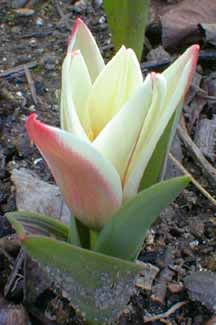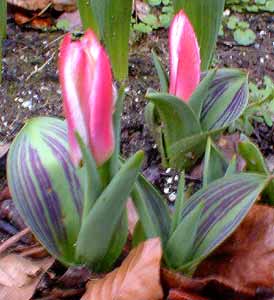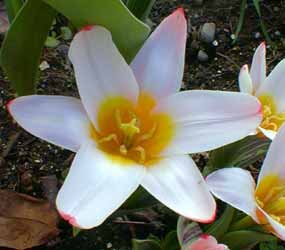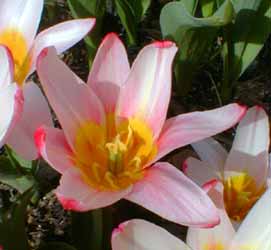
'Heart's Delight'
Waterlily Tulip
"The tulip in her lifted chalice bears
A dewy wine of Heaven's minist'ring."
-Hafiz (1325-1389)
tr. by Gertrude Bell
tr. by Gertrude Bell
"The tulip season commences with the appearance of T. kaufmanniana," said E. A. Bowles in his 1914 volume My Garden in Spring. He recommends planting the bulbs at least six inches deep. Bulbs that do nicely closer to the surface can be planted in a layer above Kaufmanniana.
 The second bulb should probably be something grassy because the Kaufmannianas can alone form such a dense groundcover of fat leaves, & enormous wide-open flowers, which together entirely shade the ground. Companionable possibilities may be found among the smaller bulb varieties of alliums, any that will send up a bit of tallish thin grass to get started early in the year (when the Kaufmannianas are active) but not be ready to bloom until the tulip's leaves are yellowing & its time to cut those back, resulting in less conflict.
The second bulb should probably be something grassy because the Kaufmannianas can alone form such a dense groundcover of fat leaves, & enormous wide-open flowers, which together entirely shade the ground. Companionable possibilities may be found among the smaller bulb varieties of alliums, any that will send up a bit of tallish thin grass to get started early in the year (when the Kaufmannianas are active) but not be ready to bloom until the tulip's leaves are yellowing & its time to cut those back, resulting in less conflict.We tried permitting a large drift of Muscari latifolium intrude into the Kaufmanniana patch, not too many because of the fear the muscaris would be too small to compete with the larger tulip leaves, but they did right fine. Their very few smaller leaves were able to reach upward just enough to get their share of sunlight. Well before the Kaufmannianas were finished blooming, there were poking up here & there amidst the red & white tulips with sparkling blue heads of the bicolor muscaris.
 The bright blue blooms of this muscari are maturing immediately after the kaufmannianas are going full guns. The water-lily tulips are already showing off very early in March, & the bicolor grape hyacinth catches up with it by mid-month, its flowers being before then unobtrusively eency.
The bright blue blooms of this muscari are maturing immediately after the kaufmannianas are going full guns. The water-lily tulips are already showing off very early in March, & the bicolor grape hyacinth catches up with it by mid-month, its flowers being before then unobtrusively eency.When the muscaris do catch up to the tulips, they make a charming mix, blooming together the rest of March. The water-lily tulips are done by April, but muscari's persist through the month, keeping color in the location. Further, since we planted eighteen 'Heart's Delight' bulbs in front of a taller lily-flowering T. retroflexa 'Ballerina,' when the water-lily tulips are finished, the lily-flowering tulips take over.
Some varieties of Kaufmanniana or Waterlily Tulips can be a bit floppy, but 'Heart's Delight' is well sustained by its own large leaves. Having a second bulb's leaves in & amidst the Waterlily Tulips adds to the thickness of the patch so that blooms are decreasingly apt to flop.
 Kaufmannianas are called "waterlily type" because when fully opened on a very sunny day, they are flat & starshaped, reminiscent of waterlilies. They do not, of course, live in water, nor even require much watering, liking moist well-drained soil when active, & rather dry soil when dormant.
Kaufmannianas are called "waterlily type" because when fully opened on a very sunny day, they are flat & starshaped, reminiscent of waterlilies. They do not, of course, live in water, nor even require much watering, liking moist well-drained soil when active, & rather dry soil when dormant.'Heart's Delight' is a name that echos a Sufi understanding of tulips having arisen from the blood of martyrs. It signifies Divine Desire, which is that component of our being that inspires in each of us the sacred quest, for Divinity is as the only true Heart's Delight.
In Europe, most infamously during Holland's tulip mania, the divine quest became corrupted into a greedy excess within which vast wealth was traded away for a handful of rare bulbs. Such tulip madness becomes comprehensible if we view it in context of a desire for the Divine gone awry, so that people would literally lust, spend, & murder for posession of rare tulips, in an excess of devotion matched only by the spirit of Jihads & Crusades.
'Heart's Delight' grows to ten inches height or thereabouts, & the flowers are a rich carmine red on the outside of the petals, white aging to pale rose on the interior, with yellow heart. On overcast days the flowers remain partially closed so are bright carmine, but on sunny days when open flat the paler interior dominates.
The first three consecutive photos on this page were taken at intervals between March first & March eighth, when there is the most creamy white displayed by the inner petals. The fourth photo is later in March when the creamy white interior of the petals is aging to a rosey pink. The petals will continue to darken so that they're entirely carmine on the outside & the rosiest pink on the inside, until by March's end the petals are tumbling away, spent.
This variety was registered in 1952 by the famed Dutch grower C. G. van Tubergen, the source of the bulbs we've planted. As a botanical hybrid it does not naturalize & spread as will wilder kaufmannianas, but the bulbs should perennialize in-place & produce flowers for many an early spring.